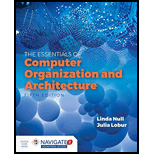
a)
Explanation of Solution
Converting “100001.111” to decimal equivalent:
Step 1: First separate the given binary fractions into two parts, left binary part and right binary fractions.
Step 2: To convert the binary fraction into decimal number, multiply the left part of the binary number with the positive integers for base 2.
Step 3: Multiply the right part of the binary number with the negative integers for base 2.
Step 4: Add all the values to get the final result.
Thus, the decimal equivalent of 100001.111 is “
b)
Explanation of Solution
Converting “111111.10011” to decimal equivalent:
Step 1: First separate the given binary fractions into two parts, left binary part and right binary fractions.
Step 2: To convert the binary fraction into decimal number, multiply the left part of the binary number with the positive integers for base 2.
Step 3: Multiply the right part of the binary number with the negative integers for base 2.
Step 4: Add all the values to get the final result.
Thus, the decimal equivalent of 111111.10011 is “
c)
Explanation of Solution
Converting “1001100.1011” to decimal equivalent:
Step 1: First separate the given binary fractions into two parts, left binary part and right binary fractions.
Step 2: To convert the binary fraction into decimal number, multiply the left part of the binary number with the positive integers for base 2.
Step 3: Multiply the right part of the binary number with the negative integers for base 2.
Step 4: Add all the values to get the final result.
Thus, the decimal equivalent of 1001100.1011 is “
d)
Explanation of Solution
Converting “10001001.0111” to decimal equivalent:
Step 1: First separate the given binary fractions into two parts, left binary part and right binary fractions.
Step 2: To convert the binary fraction into decimal number, multiply the left part of the binary number with the positive integers for base 2.
Step 3: Multiply the right part of the binary number with the negative integers for base 2.
Step 4: Add all the values to get the final result.
Thus, the decimal equivalent of 10001001.0111 is “
Want to see more full solutions like this?
Chapter 2 Solutions
Essentials of Computer Organization and Architecture
- [5 marks] Give a recursive definition for the language anb2n where n = 1, 2, 3, ... over the alphabet Ó={a, b}. 2) [12 marks] Consider the following languages over the alphabet ={a ,b}, (i) The language of all words that begin and end an a (ii) The language where every a in a word is immediately followed by at least one b. (a) Express each as a Regular Expression (b) Draw an FA for each language (c) For Language (i), draw a TG using at most 3 states (d) For Language (ii), construct a CFG.arrow_forwardQuestion 1 Generate a random sample of standard lognormal data (rlnorm()) for sample size n = 100. Construct histogram estimates of density for this sample using Sturges’ Rule, Scott’s Normal Reference Rule, and the FD Rule. Question 2 Construct a frequency polygon density estimate for the sample in Question 1, using bin width determined by Sturges’ Rule.arrow_forwardGenerate a random sample of standard lognormal data (rlnorm()) for sample size n = 100. Construct histogram estimates of density for this sample using Sturges’ Rule, Scott’s Normal Reference Rule, and the FD Rule.arrow_forward
- Can I get help with this case please, thank youarrow_forwardI need help to solve the following, thank youarrow_forwardreminder it an exercice not a grading work GETTING STARTED Open the file SC_EX19_EOM2-1_FirstLastNamexlsx, available for download from the SAM website. Save the file as SC_EX19_EOM2-1_FirstLastNamexlsx by changing the “1” to a “2”. If you do not see the .xlsx file extension in the Save As dialog box, do not type it. The program will add the file extension for you automatically. With the file SC_EX19_EOM2-1_FirstLastNamexlsx still open, ensure that your first and last name is displayed in cell B6 of the Documentation sheet. If cell B6 does not display your name, delete the file and download a new copy from the SAM website. Brad Kauffman is the senior director of projects for Rivera Engineering in Miami, Florida. The company performs engineering projects for public utilities and energy companies. Brad has started to create an Excel workbook to track estimated and actual hours and billing amounts for each project. He asks you to format the workbook to make the…arrow_forward
 Database System ConceptsComputer ScienceISBN:9780078022159Author:Abraham Silberschatz Professor, Henry F. Korth, S. SudarshanPublisher:McGraw-Hill Education
Database System ConceptsComputer ScienceISBN:9780078022159Author:Abraham Silberschatz Professor, Henry F. Korth, S. SudarshanPublisher:McGraw-Hill Education Starting Out with Python (4th Edition)Computer ScienceISBN:9780134444321Author:Tony GaddisPublisher:PEARSON
Starting Out with Python (4th Edition)Computer ScienceISBN:9780134444321Author:Tony GaddisPublisher:PEARSON Digital Fundamentals (11th Edition)Computer ScienceISBN:9780132737968Author:Thomas L. FloydPublisher:PEARSON
Digital Fundamentals (11th Edition)Computer ScienceISBN:9780132737968Author:Thomas L. FloydPublisher:PEARSON C How to Program (8th Edition)Computer ScienceISBN:9780133976892Author:Paul J. Deitel, Harvey DeitelPublisher:PEARSON
C How to Program (8th Edition)Computer ScienceISBN:9780133976892Author:Paul J. Deitel, Harvey DeitelPublisher:PEARSON Database Systems: Design, Implementation, & Manag...Computer ScienceISBN:9781337627900Author:Carlos Coronel, Steven MorrisPublisher:Cengage Learning
Database Systems: Design, Implementation, & Manag...Computer ScienceISBN:9781337627900Author:Carlos Coronel, Steven MorrisPublisher:Cengage Learning Programmable Logic ControllersComputer ScienceISBN:9780073373843Author:Frank D. PetruzellaPublisher:McGraw-Hill Education
Programmable Logic ControllersComputer ScienceISBN:9780073373843Author:Frank D. PetruzellaPublisher:McGraw-Hill Education





